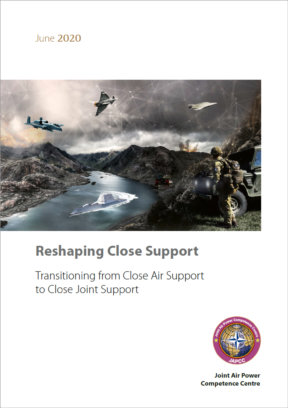Prelude
A Future Vision of Close Joint Support
Troops are in contact across a broad, disjointed front. Joint Fires Controllers (JFCs) and their assigned teams of Joint Fires Observers (JFOs) are in high demand and are faced with a daunting environment. They operate under overlapping layers of modern enemy air defences, with contested communications and against an enemy that is adept at movement and concealment. Thankfully, JFCs and JFOs have trained ‘cross-domain’ for years, effectively utilizing linked simulators and large Close Joint Support exercises to train throughout the spectrum of these environments. They are equipped with the latest digital radio equipment, including gateways for multiple message formats, and mobile communication terminals. They are also prepared for ‘old school’ voice-only communications with minimal digital aids. They are ready.
A mixed flight of a Forward Air Controller (Airborne) (FAC(A)) F-35, multi-role F-16s (SEAD and attack), F/A-18Es (SEAD and attack), and embedded EA-18Gs (EW) terrain mask away from the fight. The F-35s climb just enough to ensure digital communications are established with the Joint Fires Support Coordinator (JFSC) of the supported brigade combat team so the aircrew can build situational awareness of the battlefield and report the aircraft status to the Multi-Domain Command and Control System (MDC2S). The F-35s, in turn, relay the battlefield picture to the F-16s, F-18s, and EA-18s through various data protocols.
With hardly a spoken word, the JFC calls for fire through digital means. The MDC2S has data about all connected weapon systems across all domains and processes the request in real-time. While considering time-on-target and weapon effect radii, the MDC2S presents a computer prioritized list of available attack options together with the respective Collateral Damage Estimate (CDE) to the JFSC. The JFSC confirms the MDC2S proposal of assigning the F-35’s mixed flight to the fire mission. All ‘players’ acknowledge the data and follow the F-35’s lead as he/she ‘quarterbacks’ the attack and coordinates each asset’s roles.
On cue, the team executes a coordinated attack on a motorized, enemy fire team. The aircraft attack under a protective bubble provided by the F-35, EA-18s and UAS. These aircraft jam enemy radars and enemy communications and sweep the skies for enemy aircraft. The F-16s and F-18s use their multi-role capabilities to release network-enabled weapons, which are subsequently guided by the JFC to the target, while simultaneously searching for radar threats to target with their hypersonic ARMs (anti-radiation missiles). The aircraft are in and out of the most lethal threat envelopes in minutes and one of the JFC’s JFOs confirms the enemy fire team has been neutralized.
However, the fight rages across a long and disparate front, and there aren’t enough airborne assets to service every validated fire support request. Consequently, a distant JFC finds itself in heavy contact against mounted enemy with heavy direct fires capabilities and are in danger of being overrun. The digital urgent troops-in-contact message goes out on the MDC2S, requesting to interdict and destroy the advancing enemy. The troops-in-contact message is now prioritized by the MDC2S and the system proposes to assign two MLRS rocket launchers to deliver a short duration scatterable minefield and three artillery platoons to destroy the enemy vehicles once they hit the mine barrier. The JFSC coordinates with the CAOC through a ‘dynamic airspace synchronization’ application and ensures that the artillery is cleared to fire through CAOC controlled airspace. Tactical UASs, all tied into the multi-domain net, position to assist with adjusting fires. Within minutes from first contact, the scatterable minefield stops the advancing enemy and forces him to dismount his infantry. The artillery gun’s target coordinates are updated in real-time by the supporting UAS and the JFOs on the scene, adjusting the fires into the massing infantry, effectively ending the dismounted attack. However, the fight is not over.
An enemy tracked, large calibre weapon system arrives on the scene and begins to fire, with devastating effects. Despite having crew-served weapons, friendly troops are in danger of being torn apart. The JFC updates the TIC request to reflect the presence of a large weapons system and the effect it’s having on friendly troops. Help comes far away, but arrives quite quickly.
One of the Navy’s new ‘Large Surface Combatant’ (LSC) ships, equipped with the newest hypervelocity weapon system, is near-by and automatically populated within the MDC2S. The list of available weapons is sent to the JFSC and from having ample experience training with naval gunfire support, the JFCS quickly selects the projectile. Dynamic, real-time coordination occurs with the CAOC and the Navy’s Maritime Operations Center (MOC) to deconflict airspace and coordinate the close support fires. The JFC provides precision coordinates and the LSC fires on command. The projectile covers the distance in seconds. Though the ordnance is not explosive, the kinetic impact of the hypersonic rounds hitting the enemy weapons system is devastating and destroys it in-place. Having seen their firepower demolished and their troops razed by mortar fire, the enemy withdraws.











